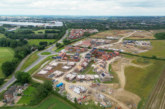
Adam Sanford, Framework Lead at Southern Construction Framework, discusses the importance of making the right decisions now for carbon zero buildings fit for 2050.
The reality is that Carbon Zero 2050 is happening right now. Whilst the targets may seem some way off, in truth any projects currently breaking ground need to be built on decisions that will determine whether that building remains viable in 30 years from now.
We also can’t ignore the current volatility of the energy market. Building practices that might look unaffordable right now will swiftly become money saving in the environment we are rapidly moving into of energy scarcity. We all remember the solar PV boom of 10 years ago. Despite early cynicism, it has proven to be a sound investment, especially now, with no clear exit signs out of this energy volatility. We can learn from that experience in playing a much longer game.
Having said that, it can all seem daunting and unpredictable as we collectively enter relatively unchartered territory. But, there are fundamental guiding principles and practices that we can learn from and follow right now, that will have a huge impact on future proofing buildings and take them to 2050 and beyond.
Fabric first
I can’t stress this enough. Fabric must come first. At the very start of a project, make sure you choose the right materials and insulation, particularly for buildings that are typically energy hungry, such as leisure centres for example. Building fabric first, looking at the quality of installation and making sure that your solution is right for the building’s use should be key considerations from the outset. That way, carbon zero ambitions are all the cheaper to meet later.
Passivhaus buildings are a great example because they don’t need any heating installation. Passiv in the sense that they are so well insulated, they don’t need additional heating systems. In essence, if your building can be constructed in a way that it doesn’t need mechanical systems, you can avoid unwanted mid-life and carbon upgrade costs further down the line, as and when new standards come into play.
A shift to offsite construction is a good way to achieve improved insulation standards, with much tighter tolerances giving better airtightness. Pre-built, pre-assembled mechanical and electrical elements will mean that you will need a less expensive mechanical plant to achieve a higher build quality and reliability to the fabric of the building. Even then, you might choose to use more carbon intensive materials in the construction, if you can prove a whole life benefit greater than the carbon that you are emitting through your build.
Equally, you can’t consider the building of the project and the operations of the building separately. For example, using a carbon intensive material will save many more tonnes of CO2 in a building that is energy hungry, whereas a more traditional office or school might benefit from using a lightweight timber, low carbon installation.
Consult your supply chain
Link to the supply chain as early as possible. You can reduce the risk of using new and innovative technologies by pooling all the expertise available to you and getting your supply chain to show you places where carbon saving practices and materials have been proven already. That way, by the time you go for planning permission you can already show an exemplar building future-proof for carbon zero — based on experience, combined expertise and knowledge.
Demolish vs re-use
There is an argument for getting what you need from the existing building and measuring by outcomes, not process. RIBA is calling for a retrofit renaissance by campaigning for a demolition tax to be levied against construction companies demolishing perfectly viable buildings to make way for brand new buildings. Even if your building isn’t that cost-efficient now, by re-using the concrete shell that cost all that embodied carbon, you are saving the demolition and processing of material that was perfectly good and reliable.
We always recommend that architects and contractors work together early to decide the best option before investing in a route that hasn’t fully explored all the options, which could include a retrofit. Get together a team that is diverse enough to give you a broad opinion of what your outcomes need to be. If the conversations to either demolish or refurb can happen before planning permission, then you can ask for advice early and there is a greater likelihood of coming up with the right solution.
In any building project, we need to be making as a minimum 30-year decisions to ensure that the building exists and remains viable in a carbon zero future. We need to be thinking about costs in the long-term and reminding ourselves that if we do it right from the start, we will save money further down the line. And that isn’t about investing huge sums, it is about getting the right expertise and advice so that the fabric and operations of the building will stand the test of time.








